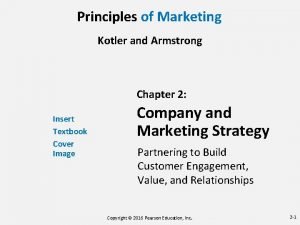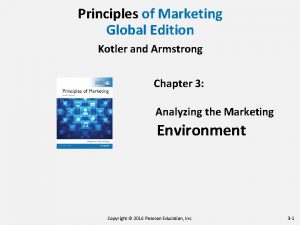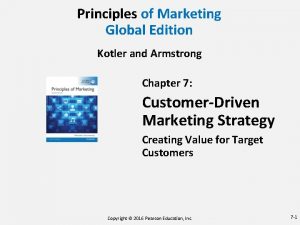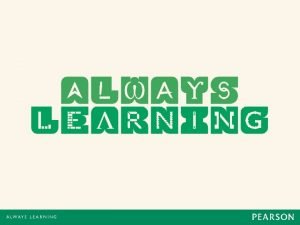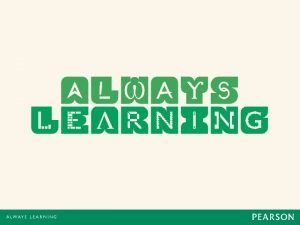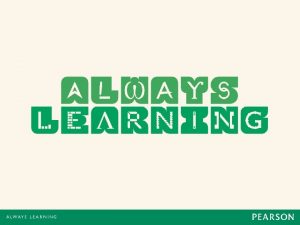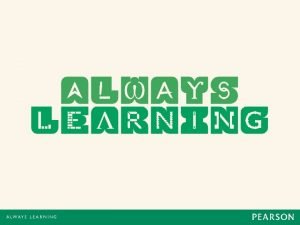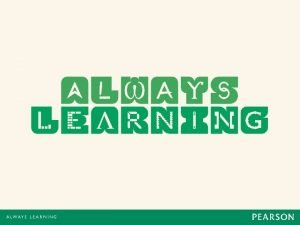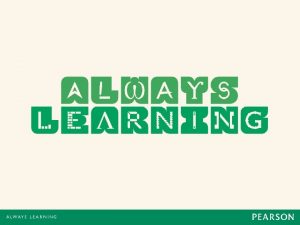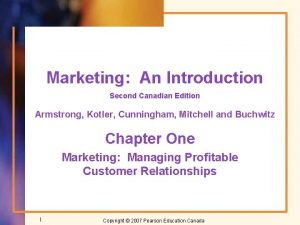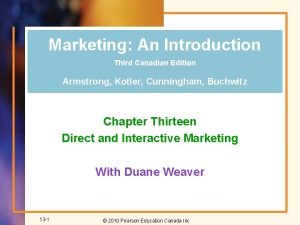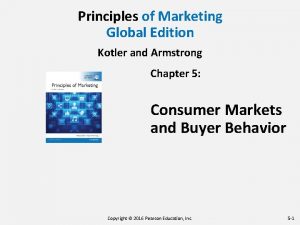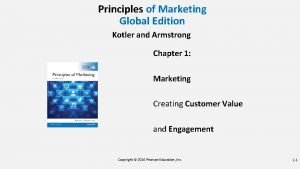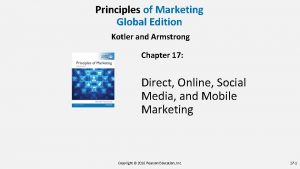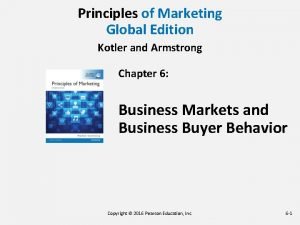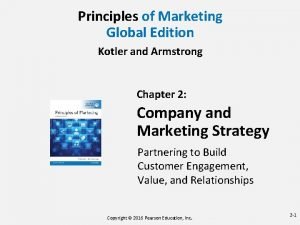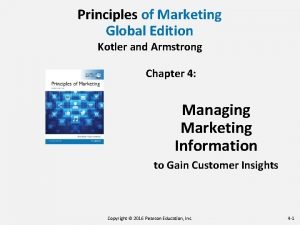Marketing An Introduction Sixth Canadian Edition Armstrong Kotler


























- Slides: 26

Marketing: An Introduction Sixth Canadian Edition Armstrong, Kotler, Trifts, Buchwitz Chapter Eleven Marketing Channels 11 -1

Outline � � � Define marketing channels and describe the main types of marketing channels for business and consumer products. Explain the role of the members of the marketing channel, and how they add value to the marketing process. List the types and forms of retailing, and the major marketing decisions retailers make. Describe the major channel design decisions, including international channels. Define and describe supply chain management. 11 -2

Marketing or Distribution Channel � A set of interdependent organizations involved in the process of making a product or service available for use or consumption by the consumer or business user. � A well designed channel provides value to customers and provides a competitive advantage to the organization. 11 -3

Why Use Channel Members � The use of intermediaries results from their greater efficiency in making goods available to target markets. (e. g. : ECONOMIES OF SCALE) � Offers the firm more than it can achieve on its own through the intermediaries: � Contacts. � Experience. � Specialization. � Scale of operation. 11 -4

in-class notes How Channel Partners Add Value • Reduce the number of transactions • Information functions • Help customize marketing offers • Handle logistics • After sales services • Support in promotional activities 11 -5

in-class notes Members of the Marketing Channel � Direct marketing channel �A channel that has no intermediary levels: direct from manufacture to the consumer � Indirect marketing channel � Distributors � Wholesalers � Jobbers, Drop Shippers, Agents, Brokers � Retailers 11 -6

Image source: Coughlan, et. al, 2006, p. 74 11 -7

Distributors and Wholesalers � � � A distributor is a company that physically distributes or moves the product from one geographical location to another. Usually from the manufacturer to the wholesaler or retailer The distributor also carries out the function of a wholesaler A wholesaler usually buys goods on bulk from the manufacturer or the distributor, and sells products in relatively smaller quantities to retailers 11 -8

Jobbers, Agents and Brokers Jobbers & Drop Ship Jobbers & Rackers A marketing intermediary that delivers inventory to retailers, sets it up in the store, and removes unsold items (the latter taking possession of the goods) Agent A marketing intermediary that acts on behalf of the buyer (retailer) or seller (manufacturer or wholesaler), but who does not take ownership of the product Broker A marketing intermediary that negotiates deals between buyer and seller, but who does not take ownership of the product 11 -9

Retailers � � All activities involved in selling goods or services directly to final consumers for their personal (not business) use. Performs important functions in the channel. This is the closest channel to the final consumer. They are classified in many ways. 11 -10

in-class notes Classification of Retailers � � By level of service: self service, limited service, full service By price: discount, off-price, independent, factory outlet, warehouse club By product line: specialty store, department store, supermarket, convenience store, superstore By retailer organization: chain store, franchise 11 -11

Classification by Level of Service � Self-service retailers: � Serve customers who are willing to perform their own “locate-compare-select” process to save money. � Limited-service retailers: � Provide more sales assistance because they carry more shopping goods about which customers need information. � Full-service retailers: � Usually carry more specialty goods for which customers like to be “waited on. ” 11 -12

Classification by Product Lines They Carry � Specialty stores. � Narrow � Department stores. � Wide � variety of product lines. Supermarkets. � Wide � product line, deep assortment. variety of food, laundry, household products. Convenience stores. � Limited line of high-turnover goods. 11 -13

Based on Product Lines They Carry � Superstores. � Large � Category killer. � Big � assortment of food and non-food items. box specialty store. Service retailers. � Provide services rather than tangible goods. 11 -14

Based on Price Classification � � Discount stores. � Sells standard merchandise at lower prices by accepting lower margins and selling at higher volume. Off-price retailers. � Buys at below wholesale, sells at less than retail. Independent retailers – owned by single owners Factory outlets – operated by the manufacturer Warehouse clubs – limited selection at discounts to membership. 11 -15

Based on Retailer Organization � Chain Stores � Two or more outlets that owned and controlled by corporation and centrally managed. � Franchise organizations. � Contractual association between a manufacturer, wholesaler and independent business people. 11 -16

Retailer Marketing Decisions � Retailer strategy. � Segmentation � Target market. � Differentiation � Retail store positioning. � Retailer marketing mix. � Product assortment. � Prices. � Promotion. � Place (location). 11 -17

Channel Conflict � � Disagreement between members over goals and roles. Horizontal conflict. �Conflict � Vertical conflict. �Conflict � between firms on the same level. between firms on different levels. Disintermediation. �Displacement of a traditional member from the marketing channel. �Selling direct via the Internet. Copyri ght © 2007 Pearso n Educat ion Canad a 11 -18

in-class notes Organization of Marketing Channels � Vertical Marketing Channel � � Horizontal Marketing System � � A channel arrangement in which two or more companies at one level join together to follow a new marketing opportunity. Multichannel distribution system � � A distribution channel structure in which producers, wholesalers and retailers act as a unified system. Is where a single form sets up two or more channels to reach one or more customer segments Disintermediation � the cutting out of marketing channel intermediaries by product or service producers or the displacement of traditional resellers by radical new types of intermediaries 11 -19

Disintermediation � � The use of internet as a marketing channel created the gradual disintermediation of physical channels Presents both opportunities an well as threats � Opportunities could be to develop innovative channels. � Threats would be for traditional channels if not adopt some new formats may eventually will run out of business. 11 -20

in-class notes Designing Marketing Channels � � � Analyzing customer needs Setting channel objectives Selecting channel alternatives � Types of intermediaries � Number of intermediaries (intensive, exclusive or selective) 11 -21

How Many Intermediaries � Intensive distribution. � As � many distributors as possible. Exclusive distribution. � Only � one distributor in a given territory. Selective distribution. �A select few distributors in a given territory. 11 -22

in-class notes Designing International Marketing Channels � Has the option of using 3 entry strategies � Exporting � Joint venturing Licensing Contract manufacturing Management contracting Joint ownership � Direct investment 11 -23

Critical Marketing Management: Logistics and Supply Chain � The tasks involved in planning, implementing, and controlling the physical flow of materials, final goods, and related information from points of origin to points of consumption to meet customer requirements at a profit. 11 -24

in-class notes Logistics and Supply Chain Management � Major supply chain management tasks include � Managing warehouses � Managing inventory � Transportation of goods � Managing logistics information � Order processing � Managing just in time logistics systems 11 -25

THANK YOU FOR YOUR TIME 11 -26
 Principles of marketing ppt chapter 2
Principles of marketing ppt chapter 2 Kotler armstrong marketing
Kotler armstrong marketing Marketing an introduction 6th canadian edition
Marketing an introduction 6th canadian edition Customer driven marketing strategy
Customer driven marketing strategy Marketing management (arab world edition) philip kotler
Marketing management (arab world edition) philip kotler Marketing management (arab world edition) philip kotler
Marketing management (arab world edition) philip kotler Marketing management (arab world edition) philip kotler
Marketing management (arab world edition) philip kotler What are the keys to effective internal marketing
What are the keys to effective internal marketing Kotler e keller
Kotler e keller Marketing management (arab world edition) philip kotler
Marketing management (arab world edition) philip kotler Mmodation
Mmodation Rubber baby buggy bumpers tongue twister lyrics
Rubber baby buggy bumpers tongue twister lyrics Biochemistry sixth edition
Biochemistry sixth edition Computer architecture a quantitative approach sixth edition
Computer architecture a quantitative approach sixth edition Automotive technology sixth edition
Automotive technology sixth edition Automotive technology sixth edition
Automotive technology sixth edition Apa sixth edition
Apa sixth edition Computer architecture a quantitative approach sixth edition
Computer architecture a quantitative approach sixth edition Precalculus sixth edition
Precalculus sixth edition Principles of economics sixth edition
Principles of economics sixth edition Computer architecture a quantitative approach sixth edition
Computer architecture a quantitative approach sixth edition Accounting principles second canadian edition
Accounting principles second canadian edition Accounting principles second canadian edition
Accounting principles second canadian edition Accounting principles second canadian edition
Accounting principles second canadian edition Sujata madan
Sujata madan Accounting principles second canadian edition
Accounting principles second canadian edition Fundamentals of corporate finance third canadian edition
Fundamentals of corporate finance third canadian edition
